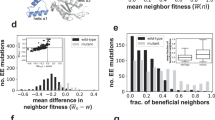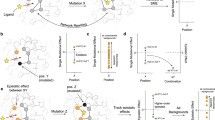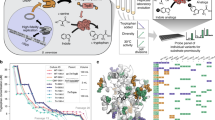Abstract
Cryptic variation is caused by the robustness of phenotypes to mutations1. Cryptic variation has no effect on phenotypes in a given genetic or environmental background, but it can have effects after mutations or environmental change2,3,4,5. Because evolutionary adaptation by natural selection requires phenotypic variation, phenotypically revealed cryptic genetic variation may facilitate evolutionary adaptation6,7,8. This is possible if the cryptic variation happens to be pre-adapted, or “exapted”9, to a new environment, and is thus advantageous once revealed. However, this facilitating role for cryptic variation has not been proven, partly because most pertinent work focuses on complex phenotypes of whole organisms whose genetic basis is incompletely understood. Here we show that populations of RNA enzymes with accumulated cryptic variation adapt more rapidly to a new substrate than a population without cryptic variation. A detailed analysis of our evolving RNA populations in genotype space shows that cryptic variation allows a population to explore new genotypes that become adaptive only in a new environment. Our observations show that cryptic variation contains new genotypes pre-adapted to a changed environment. Our results highlight the positive role that robustness and epistasis can have in adaptive evolution10,11.
This is a preview of subscription content, access via your institution
Access options
Subscribe to this journal
Receive 51 print issues and online access
We are sorry, but there is no personal subscription option available for your country.
Buy this article
- Purchase on SpringerLink
- Instant access to full article PDF
Prices may be subject to local taxes which are calculated during checkout



Similar content being viewed by others
References
Wagner, A. Robustness and Evolvability in Living Systems. (Princeton University Press, 2005)
Gibson, G. & Dworkin, I. Uncovering cryptic genetic variation. Nature Rev. Genet. 5, 681–690 (2004)
Waddington, C. H. Genetic assimilation of an acquired character. Evolution 7, 118–126 (1953)
Rutherford, S. L. From genotype to phenotype: buffering mechanisms and the storage of genetic information. Bioessays 22, 1095–1105 (2000)
Le Rouzic, A. & Carlborg, O. Evolutionary potential of hidden genetic variation. Trends Ecol. Evol. 23, 33–37 (2008)
Rutherford, S. L. & Lindquist, S. Hsp90 as a capacitor for morphological evolution. Nature 396, 336–342 (1998)
True, H. L. & Lindquist, S. L. A yeast prion provides a mechanism for genetic variation and phenotypic diversity. Nature 407, 477–483 (2000)
Masel, J. Cryptic genetic variation is enriched for potential adaptations. Genetics 172, 1985–1991 (2006)
Gould, S. J. & Vrba, E. S. Exaptation—a missing term in the science of form. Paleobiology 8, 4–15 (1982)
Aharoni, A. et al. The ‘evolvability’ of promiscuous protein functions. Nature Genet. 37, 73–76 (2004)
Bloom, J. D., Labthavikul, S. T., Otey, C. R. & Arnold, F. H. Protein stability promotes evolvability. Proc. Natl Acad. Sci. USA 103, 5869–5874 (2006)
Tanner, M. & Cech, T. Activity and thermostability of the small self-splicing group I intron in the pre-tRNA(lle) of the purple bacterium Azoarcus . RNA 2, 74–83 (1996)
Kuo, L. Y., Davidson, L. A. & Pico, S. Characterization of the Azoarcus ribozyme: tight binding to guanosine and substrate by an unusually small group I ribozyme. Biochim. Biophys. Acta 1489, 281–292 (1999)
Stahley, M. R. & Strobel, S. A. Structural evidence for a two-metal-ion mechanism of group I intron splicing. Science 309, 1587–1590 (2005)
Rangan, P., Masquida, B., Westhof, E. & Woodson, S. A. Assembly of core helices and rapid tertiary folding of a small bacterial group I ribozyme. Proc. Natl Acad. Sci. USA 100, 1574–1579 (2003)
Pan, J. & Woodson, S. A. Folding intermediates of a self-splicing RNA: mispairing of the catalytic core. J. Mol. Biol. 280, 597–609 (1998)
Beaudry, A. A. & Joyce, G. F. Directed evolution of an RNA enzyme. Science 257, 635–641 (1992)
Lehman, N. & Joyce, G. F. Evolution in vitro of an RNA enzyme with altered metal dependence. Nature 361, 182–185 (1993)
Blake, R. D. & Delcourt, S. G. Thermodynamic effects of formamide on DNA stability. Nucleic Acids Res. 24, 2095–2103 (1996)
O'Brien, P. J. & Herschlag, D. Catalytic promiscuity and the evolution of new enzymatic activities. Chem. Biol. 6, R91–R105 (1999)
Hartl, D. L. & Clark, A. G. Principles of Population Genetics. (Sinauer Associates, 1997)
Hanczyc, M. M. & Dorit, R. L. Experimental evolution of complexity: in vitro emergence of intermolecular ribozyme interactions. RNA 4, 268–275 (1998)
Lawrence, M. S. & Bartel, D. P. New ligase-derived RNA polymerase ribozymes. RNA 11, 1173–1180 (2005)
Ouellet, J., Byrne, M. & Lilley, D. M. Formation of an active site in trans by interaction of two complete Varkud Satellite ribozymes. RNA 15, 1822–1826 (2009)
Kondrashov, F. A. & Kondrashov, A. S. Multidimensional epistasis and the disadvantage of sex. Proc. Natl Acad. Sci. USA 98, 12089–12092 (2001)
Wilke, C., Lenski, R. & Adami, C. Compensatory mutations cause excess of antagonistic epistasis in RNA secondary structure folding. BMC Evol. Biol. 3, 3 (2003)
Weinreich, D. M., Delaney, N. F., Depristo, M. A. & Hartl, D. L. Darwinian evolution can follow only very few mutational paths to fitter proteins. Science 312, 111–114 (2006)
Hermisson, J. & Wagner, G. P. The population genetic theory of hidden variation and genetic robustness. Genetics 168, 2271–2284 (2004)
Rydzanicz, R., Zhao, X. S. & Johnson, P. E. Assembly PCR oligo maker: a tool for designing oligodeoxynucleotides for constructing long DNA molecules for RNA production. Nucleic Acids Res. 33, W521–W525 (2005)
Hochberg, Y. & Benjamini, Y. Controlling the false discovery rate: a practical and powerful approach to multiple testing. J. R. Stat. Soc. B 57, 289–300 (1995)
Cadwell, R. C. & Joyce, G. F. Randomization of genes by PCR mutagenesis. Genome Res. 2, 28–33 (1992)
Eckert, K. A. & Kunkel, T. A. DNA polymerase fidelity and the polymerase chain reaction. Genome Res. 1, 17–24 (1991)
Breaker, R. R. & Joyce, G. F. Inventing and improving ribozyme function: Rational design versus iterative selection methods. Trends Biotechnol. 12, 268–275 (1994)
Needleman, S. B. & Wunsch, C. D. A general method applicable to the search for similarities in the amino acid sequence of two proteins. J. Mol. Biol. 48, 443–453 (1970)
Yu, W., Rusterholtz, K. J., Krummel, A. T. & Lehman, N. Detection of high levels of recombination generated during PCR amplification of RNA templates. Biotechniques 40, 499–507 (2006)
Li, W. & Godzik, A. Cd-hit: a fast program for clustering and comparing large sets of protein or nucleotide sequences. Bioinformatics 22, 1658–1659 (2006)
Guindon, S. & Gascuel, O. A simple, fast, and accurate algorithm to estimate large phylogenies by maximum likelihood. Syst. Biol. 52, 696–704 (2003)
Acknowledgements
We thank R. Dhar and N. de la Chaux for bioinformatic support. We thank the Functional Genomics Center, Zurich, for collecting sequence data. We acknowledge support from Swiss National Science Foundation grants 315200-116814, 315200-119697 and 315230-129708, from the YeastX program of SystemsX.ch, and from the Research Priority Program in Systems Biology at the University of Zurich.
Author information
Authors and Affiliations
Contributions
E.J.H. and A.W. contributed to the design of the experiments; E.J.H. performed the experiments; E.J.H., E.F., and A.W. all contributed to analysis of the data and co-wrote the paper.
Corresponding author
Ethics declarations
Competing interests
The authors declare no competing financial interests.
Supplementary information
Supplementary Information
This file contains Supplementary Figures 1-7 with legends, Supplementary Table 1 and additional references. (PDF 798 kb)
Rights and permissions
About this article
Cite this article
Hayden, E., Ferrada, E. & Wagner, A. Cryptic genetic variation promotes rapid evolutionary adaptation in an RNA enzyme. Nature 474, 92–95 (2011). https://doi.org/10.1038/nature10083
Received:
Accepted:
Published:
Issue Date:
DOI: https://doi.org/10.1038/nature10083
This article is cited by
-
Robustness and innovation in synthetic genotype networks
Nature Communications (2023)
-
Phenotype-first hypotheses, spandrels and early metazoan evolution
History and Philosophy of the Life Sciences (2022)
-
Evidence for population expansion of Cotton pink bollworm Pectinophora gossypiella (Saunders) (Lepidoptera: Gelechiidae) in India
Scientific Reports (2020)
-
Effects of Phenotypic Robustness on Adaptive Evolutionary Dynamics
Evolutionary Biology (2020)
-
The causes of evolvability and their evolution
Nature Reviews Genetics (2019)



